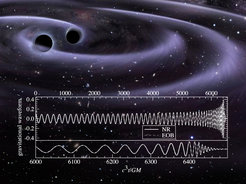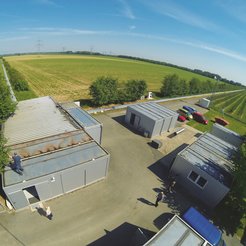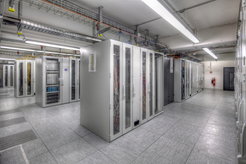A large step closer to the first direct detection of gravitational waves
Albert Einstein Institute researchers make key contributions to advanced LIGO gravitational-wave detectors
On May 19, the LIGO Scientific Collaboration (LSC) will dedicate their second-generation gravitational-wave detectors (aLIGO) in a ceremony at the Hanford detector site. Researchers at the Max Planck Institute for Gravitational Physics (Albert Einstein Institute; AEI) in Hannover and Potsdam, Germany, have made significant contributions in several key areas: custom-made high-power laser systems required for the high-precision measurements, efficient data analysis methods running on powerful computer clusters, and accurate waveform models to detect gravitational waves and extract astrophysical information. The AEI is a leading partner in the international gravitational-wave science community, and its researchers keep pushing the boundaries of science on the way to the first direct detection of gravitational waves.
This will open a new window to the otherwise invisible “dark” side of the Universe and mark the beginning of gravitational-wave astronomy. Gravitational waves are ripples in space-time that are emitted by cataclysmic cosmic events such as exploding stars, merging black holes and/or neutron stars, and rapidly rotating compact stellar remnants. These waves were predicted in 1916 by Albert Einstein as a consequence of his general theory of relativity, but have never been observed directly. At their design sensitivity, the aLIGO instruments should detect multiple gravitational-wave events each year.
GEO600 contributes advanced detector techniques
Researchers at the AEI together with the Laser Zentrum Hannover developed and installed the high-power laser systems used in the aLIGO detectors. “With our UK colleagues we designed and operate the gravitational-wave detector GEO600. We use it as a think tank and testbed for advanced detector techniques,” says AEI director Prof. Karsten Danzmann, who is also the director of the Institute for Gravitational Physics at the Leibniz Universität Hannover. “Many of these new methods are now in use at the aLIGO detectors, such as signal recycling and monolithic mirror suspensions.” Danzmann's AEI division plays a pioneering role in the development and application of non-classical light in gravitational-wave detectors. GEO600 is the only detector worldwide using squeezed light to improve the detector sensitivity beyond limits set by the quantum nature of light.
Leading partner in data analysis with powerful supercomputers
AEI scientists develop and implement advanced and efficient data analysis methods to search for weak gravitational-wave signals in the aLIGO detector data streams. “The AEI is a leading partner in the global joint data analysis efforts of the LSC,” says Prof. Bruce Allen, director at the AEI. “For this purpose we operate Atlas, the most powerful computer cluster in the world designed for gravitational-wave data analysis.” During the first data-taking run in late 2015, Allen's division will search through the data on the Atlas cluster. Together with US partners the division also operates Einstein@Home, a global volunteer distributed computing project for gravitational-wave data analysis. Almost 400,000 volunteers from all over the world have contributed computing time over the past decade on their home PCs, laptops, or smartphones.
Developing accurate waveform models and extracting unique information from observed signals
Using sophisticated analytical approximation methods to the theory of general relativity, AEI scientists develop accurate waveform models for the most promising gravitational-wave sources. “We have developed the most accurate waveform models so far of merging black holes. Together with our LSC colleagues we will conduct a search for those signals in the first aLIGO data-taking run in late 2015 using the Atlas cluster. Gravitational-wave observations of these systems will give us completely new insights into these otherwise invisible objects,” says Prof. Alessandra Buonanno, director at the AEI in Potsdam. “The waveform models used for the upcoming search include the full coalescence process (inspiral, merger and ringdown) and for the first time they contain effects of the black holes' spins, which will improve the sensitivity and thereby our chances of detection.” AEI scientists, in collaboration with LSC colleagues, have also prepared a follow-up analysis for the first observation run that will infer astrophysical parameters of the merging black holes.
Next step: First observation run
aLIGO will start its first data-taking (observation) run “O1” in the autumn of 2015, bringing the era of gravitational-wave astronomy a large step closer to reality – with key contributions from the Albert Einstein Institute.
Background information
The Albert Einstein Institute is an institute of the Max Planck Society with sub-institutes in Potsdam-Golm (outside Berlin) and Hannover. Since its foundation in 1995, the Max Planck Institute for Gravitational Physics (Albert Einstein Institute) has established itself as a leading international research center. The research program is pursued in five divisions and several independent research groups cover the entire spectrum of gravitational physics: from the giant dimensions of the Universe to the tiny scales of strings. The AEI is the only institute in the world that brings together all of these key research fields. Three of its five divisions are part of the LIGO Scientific Collaboration and work on realizing the first direct detection of gravitational waves.
Gravitational waves are an important prediction of Einstein's theory of general relativity. Accelerated motions of large masses create ripples in space-time, which lead to tiny relative distance changes between far-away objects. Even gravitational waves emitted by astrophysical sources, like stellar explosions or merging black holes, change the length of a one-kilometer measurement distance on Earth by only one thousandth of the diameter of a proton (10-18 meters). Only now the detectors have reached a level of sensitivity at which they can measure gravitational waves. The observation of the until now dark “Gravitational Universe” will usher in a new era in astronomy. The interferometric gravitational-wave detectors such as aLIGO (in the USA), GEO600 (in Germany), and Virgo (in Italy), as well as planned detectors in Japan and India collaborate closely.

Advanced LIGO (aLIGO) consists of interferometric gravitational-wave detectors at two sites, one in Hanford (Washington State, USA) and one in Livingston (Louisiana, USA). Although still in the commissioning phase, their sensitivity to gravitational waves is already higher than ever before. aLIGO will start its first coordinated data-taking run in the autumn of 2015. At design sensitivity, a ten-fold increase in sensitivity over initial LIGO is expected. This should enable the detection of multiple gravitational-wave events each year.
GEO600 is an interferometric gravitational-wave detector with 600 meter long laser beam tubes, located near Hannover, Germany. It is designed and operated by scientists from the Max Planck Institute for Gravitational Physics and Leibniz Universität Hannover, along with partners in the United Kingdom, and is funded by the Federal Ministry of Education and Research, the State of Lower Saxony, the Max Planck Society, the Science and Technology Facilities Council (STFC), and the VolkswagenStiftung. GEO600 is part of a worldwide network of gravitational wave detectors and at the moment the only detector taking data almost continuously. GEO600 also is a think tank for advanced detector technologies, such as non-classical (squeezed) light, signal and power recycling, and monolithic suspensions.

Atlas is a large computer cluster at the Albert Einstein Institute in Hannover with enormous computing capacities. Atlas consists of more than 14,000 CPU cores and 250,000 GPU cores, making it the largest computer cluster worldwide dedicated to gravitational-wave data analysis.















